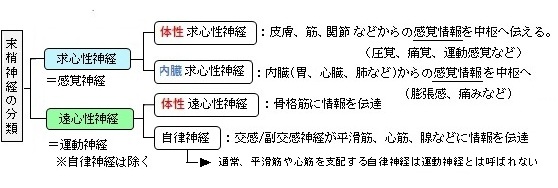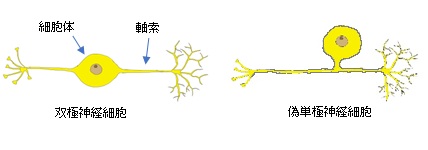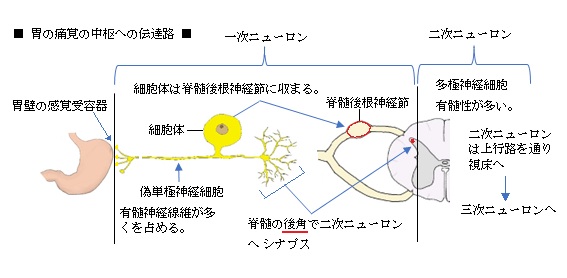【概 要】




【構成細胞】


【シナプス部位】

■体性・内臓感覚の求心性神経(偽単極神経細胞)■
神経節:脊髄後根神経節や頭蓋神経感覚節に細胞体がある
軸索:
末梢から受容器の刺激を受け取る
脊髄や脳幹に入ると一次シナプス(一次求心性線維)を形成
シナプスの主な場所:
体性感覚線維:
・痛覚・温覚 → 脊髄後角で二次ニューロンにシナプス
・触覚・位置覚 → 脊髄後根入核(nucleus gracilis / cuneatus)で二次ニューロンにシナプス
内臓感覚線維:
・胸腹部内臓 → 脊髄後角で二次ニューロンにシナプス
・頭蓋内臓(迷走神経など) → 延髄孤束核で二次ニューロンにシナプス

■特殊感覚神経(双極神経細胞)■
|
神 経 |
シナプス場所 |
備 考 |
1 |
視神経 |
網膜内で神経節細胞にシナプス |
網膜双極細胞→神経節細胞→視神経→外側膝状体など中枢 |
2 |
聴覚神経 |
蝸牛核 |
蝸牛神経節の双極細胞から直接シナプス |
3 |
前庭神経 |
前庭核 |
前庭神経節の双極細胞から直接シナプス |
4 |
嗅神経 |
嗅球の糸球体 |
嗅覚受容体→双極神経→嗅球神経細胞にシナプス |
【分 類】 参考:「ChatGPT」
■ 受容器の種類による分類 ■
求心性神経は、末梢から情報を発信する受容器の存在場所によって以下の2つに分類できる。
・受容器が内臓に存在する場合 ⇒ 内臓感覚性求心性神経
・受容器が内臓以外に存在する場合 ⇒ 体性感覚性求心性神経
| |
名 称 |
備 考 |
1 |
体性感覚性
求心性神経 |
皮膚、筋、関節などからの刺激を伝える。
例:触覚、痛覚、温度感覚、固有感覚(関節・筋の位置や張力)。 |
2 |
内臓感覚性
求心性神経 |
内臓(消化管、血管、心臓など)の状態を伝える。
例:内臓痛、血圧や化学受容体からの情報。 |
※体性求心性神経と体性感覚性求心性神経の違いは「ChatGPTに聞いてみた」を参照のこと。
■ 情報の種類による分類 ■
求心性神経は、末梢から伝わる情報の種類によって以下の4つに分類できる。
|
名 称 |
備 考 |
1 |
一般体性感覚 |
皮膚感覚(触覚、温度、痛覚)、筋・関節の固有感覚。 |
2 |
特殊体性感覚 |
視覚、聴覚、平衡感覚。 |
3 |
一般内臓感覚 |
内臓からの感覚(胃の張り、血圧など) |
4 |
特殊内臓感覚 |
味覚、嗅覚。 |
※上記の名称では「~感覚」都だけ記したが、正確には「~感覚を伝える求心性神経」となる。
■伝える情報の発信元よる分類■
| |
名 称 |
備 考 |
1 |
外受容性 |
外界からの刺激(光、音、触覚など) |
2 |
内受容性 |
体内環境からの刺激(血圧、血中酸素濃度、消化管の伸展など) |
3 |
固有受容性 |
筋・腱・関節からの情報(身体の位置や運動の感覚)。 |
【「ChatGPT」に聞いてみた】
Q.「中枢神経も求心性神経と遠心性神経に分けられるのか?」
A.「脳や脊髄の内部の神経回路については、求心性・遠心性という表現は通常あまり使いません。
・中枢神経の内部は複雑にニューロンが連絡し合っているため、末梢のように「入力方向/出力方向」で単純に整理しにくいからです。 」
・中枢では「上行路」「下行路」「抑制性」「興奮性」といった用語の方がよく使われます。
Q.「体性求心性神経と体性感覚性求心性神経という2つの名称があるが、通常、どちらが使われるのだろうか?」
A.「末梢神経や求心性神経の文献を見ると、体性求心性神経 と 体性感覚性求心性神経 は微妙にニュアンスが異なりますが、実務上の使われ方には傾向があります。
1. 体性求心性神経(somatic afferent nerve)
2. 体性感覚性求心性神経(general somatic afferent, GSA)
🔹 まとめると
【参考になるサイト】
以下は「Wikipedia」の「afferent nerve fiber(求心性神経線維)」の解説文となる。
「In the peripheral nervous system, an afferent nerve fiber is the axon of an afferent sensory neuron. It is a long process extending far from the nerve cell body that carries nerve impulses from sensory receptors or sense organs toward the central nervous system. The opposite direction of neural activity is efferent conduction.[1][2][3]
In the nervous system there is a "closed loop" system of sensation, decision, and reactions. This process is carried out through the activity of afferent neurons, interneurons, and efferent motor neurons.
A touch or painful stimulus, for example, creates a sensation in the brain only after information about the stimulus travels there via afferent nerve pathways. Afferent neurons are pseudounipolar neurons that have a single long axon with a short central and a long peripheral branch. These cells do not have dendrites.[4] They have a smooth and rounded cell body. Just outside the spinal cord, thousands of afferent neuronal cell bodies are aggregated in a swelling in the dorsal root known as the dorsal root ganglion.[5][4]
Afferent neurons' somas are located in the ganglia of the peripheral nervous system, and the axons of these cells travel from ganglion to ganglion and lead back to the spinal cord. The majority of these are unipolar neurons in that they have a single axon leaving the cell body and is sent towards the sensory organ.[5] All of the axons in the dorsal root, which contains afferent nerve fibers, are used in the transduction of somatosensory information. Somatosensory receptors include senses such as pain, touch, temperature, itch, and stretch. For example, a specific muscle fiber called an intrafusal muscle fiber is a type of afferent neuron that lies parallel to the extrafusal muscle fibers thus functions as a stretch receptor by detecting muscle length.[5] All of these sensations travel along the same general pathway towards the brain, from the dorsal root ganglion they travel to the spinal cord.[5] From the spinal cord to the medulla, which then leads to the medial lemniscus of the midbrain. From here it travels to the primary somatosensory cortex of the parietal lobe.」
【参考になるサイト】
・イラストや写真を掲載しているサイト-Ⅰ
・イラストや写真を掲載しているサイト-Ⅱ
・イラストや写真を掲載しているサイト-Ⅲ
・イラストや写真を掲載しているサイト-Ⅳ
